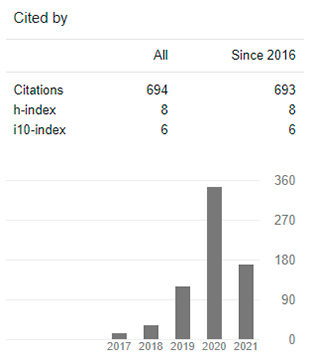The importance of developing creativity in preschool children
DOI:
https://doi.org/10.29394/Scientific.issn.2542-2987.2023.8.27.4.81-97Keywords:
creativity, children, development, preschoolAbstract
The present work aims to inform the types of thought that students handle when capturing new information, since teachers in order to teach must know and differentiate the types of thought to help the student's evolution, among these thought models we have Two very important ones are: lateral thinking and vertical thinking. We will take these two models as a central point, on the one hand, we have vertical thinking that helps the student to develop creatively and reach a result without having to follow a procedure, while vertical thinking is the opposite, since for Reaching a result requires a series of steps to follow and if these steps are not followed, you may have an undesired result. The initial question that many teachers ask themselves when studying the two models of thought is, which model of thought is the appropriate one to teach a subject? This question is very complex since if we compare these models none is better than the other, since, both the lateral and the vertical have their advantages and disadvantages and these tools can be used in parallel.
Downloads
References
Abdullah, R., Hamidi, F., & Anaraki, A. (2009). A study on the effect of science activities on fostering creativity in preschool children. Tüfed-Tused: Journal of Turkish Science Education, 6(3), 81-90, e-ISSN: 1304-6020. Recovered from: https://www.tused.org/index.php/tused/article/view/127
Amabile, T. (1992). Growing up creative: Nurturing a lifetime of creativit. 2nd edition, ISBN: 978-0930222895. United States: Creative Education Foundation.
Bono, E. (1967a,b). Pensamiento Lateral. México: Editorial Paidós.
Bueno, D. (2019). Genetics and learning: How the genes influence educational attainment. Frontiers in Psychology, 10, 1-10. Recovered from: https://doi.org/10.3389/fpsyg.2019.01622
Butcher, H. (1974). La inteligencia Humana. ISBN: 9788426902870. Madrid, España: Ediciones Marova.
Cevallos, D. (2000). La Importancia del pensamiento creativo. Illari, (1), 43-45, e-ISSN: 1390-4485. Ecuador: Universidad Nacional de Educación.
Cheseda, E., & Permata, N. (2021). How Children’s Creativity During the Covid-19 Pandemic?. Advances in Social Science, Education and Humanities Research, 563, 211-215, e-ISSN: 2352-5398. Recovered from: https://doi.org/10.2991/assehr.k.210618.042
Fernández, J. (2020). ¿Qué es el pensamiento lateral en el aprendizaje de los niños?. España: Editorial GEU.
Lichtenwalner, J., & Maxwell, J. (1969). The Relationship of Birth Order and Socio-Economic Status to the Creativity of Preschool Children. Child Development, 40(4), 1241-1247, e-ISSN: 0009-3920. Recovered from: https://doi.org/10.2307/1127028
Ming, J., Chin-Kai, L., & Bor-Chen, K. (2018a,b). Educational Attainments and Parenting Related Information associated with Parenting Skills in Mothers of Preschooler in Taiwan. Journal of Education & Social Policy, 5(1), 166-185, e-ISSN: 2375-0790. Recovered from: https://jespnet.com/journal/index/2458
Mustofa, R., & Hidayah, Y. (2020). The Effect of Problem-Based Learning on Lateral Thinking Skills. International Journal of Instruction, 13(1), 463-474, e-ISSN: 1308-1470. Recovered from: https://doi.org/10.29333/iji.2020.13130a
Navarrete, A. (2021). El uso de la plataforma zoom en el aprendizaje de ciencias naturales, en los estudiantes del Octavo grado de Educación General Básica, paralelo "A", de la unidad educativa "La Inmaculada" de la ciudad de Ambato, en el primer quimestre del año lectivo 2020-2021. Tesis. Ecuador: Universidad Técnica de Ambato.
Paige-Smith, A., & Rix, J. (2011). Researching early intervention and young children's perspectives - developing and using a ‘listening to children approach’. BJSE: British Journal of Special Education, 38(1), 28-36, e-ISSN: 1467-8578. Recovered from: https://doi.org/10.1111/j.1467-8578.2011.00494.x
Ponce, T., Vielma, C., & Bellei, C. (2021). Experiencias educativas de niñas, niños y adolescentes chilenos confinados por la pandemia COVID-19. Revista Iberoamericana de Educación, 86(1), 97-115, e-ISSN: 1681-5653. Recuperado de: https://doi.org/10.35362/rie8614415
Pugsley, L., & Acar, S. (2020). Supporting Creativity Or Conformity? Influence of Home Environment and Parental Factors on the Value of Children's Creativity Characteristics. Journal of Creative Behavior, 54(3), 598-609, e-ISSN: 0022-0175. Recovered from: https://doi.org/10.1002/jocb.393
Shi, B., Wang, L., Yang, J., Zhang, M., & Xu, L. (2017a,b). Relationship between Divergent Thinking and Intelligence: An Empirical Study of the Threshold Hypothesis with Chinese Children. Frontiers in Psychology, 8(254), 1-9, e-ISSN: 1664-1078. Recovered from: https://doi.org/10.3389/fpsyg.2017.00254
Srikongchan, W., Kaewkuekool, S., & Mejaleurn, S. (2021). Backward Instructional Design Based Learning Activities to Developing Students' Creative Thinking with Lateral Thinking Technique. International Journal of Instruction, 14(2), 233-252, e-ISSN: 1308-1470. Recovered from: https://doi.org/10.29333/iji.2021.14214a
Tacunan, J. (2020). La creatividad en niños de cinco años en un contexto de aislamiento social: una aproximación fenomenológica. Tesis. Lima, Perú: Universidad César Vallejo. Recuperado de: https://hdl.handle.net/20.500.12692/65144
Trevlas, E., Matsouka, O., & Zachopoulou, E. (2003). Relationship between playfulness and motor creativity in preschool children. Early Child Development and Care, 173(5), 535-543, e-ISSN: 0300-4430. Recovered from: https://doi.org/10.1080/0300443032000070482
UNESCO (2021). Las respuestas educativas nacionales frente a la COVID-19: el panorama de América Latina y el Caribe. París: Organización de las Naciones Unidas para la Educación, la Ciencia y la Cultura.
UNICEF (2020). Un niño/a preescolar es muy difícil que se mantenga frente a una pantalla por suficiente tiempo. Chile: Fondo de las Naciones Unidas para la Infancia.
Yahav, R. (2021a,b). Interdisciplinary Identification of Preschooler Developmental Status, Interventions and Monitoring in the Preschool System in Israel. SSRN, 1-14, e-ISSN: 1556-5068. Recovered from: https://doi.org/10.2139/ssrn.3735016
Downloads
Published
How to Cite
Issue
Section
License
Copyright (c) 2023 INDTEC, C.A.

This work is licensed under a Creative Commons Attribution-NonCommercial-ShareAlike 4.0 International License.
The content of the journals of this site, are under a Creative Commons Attribution-Noncommercial-Share Alike 4.0 International License.













